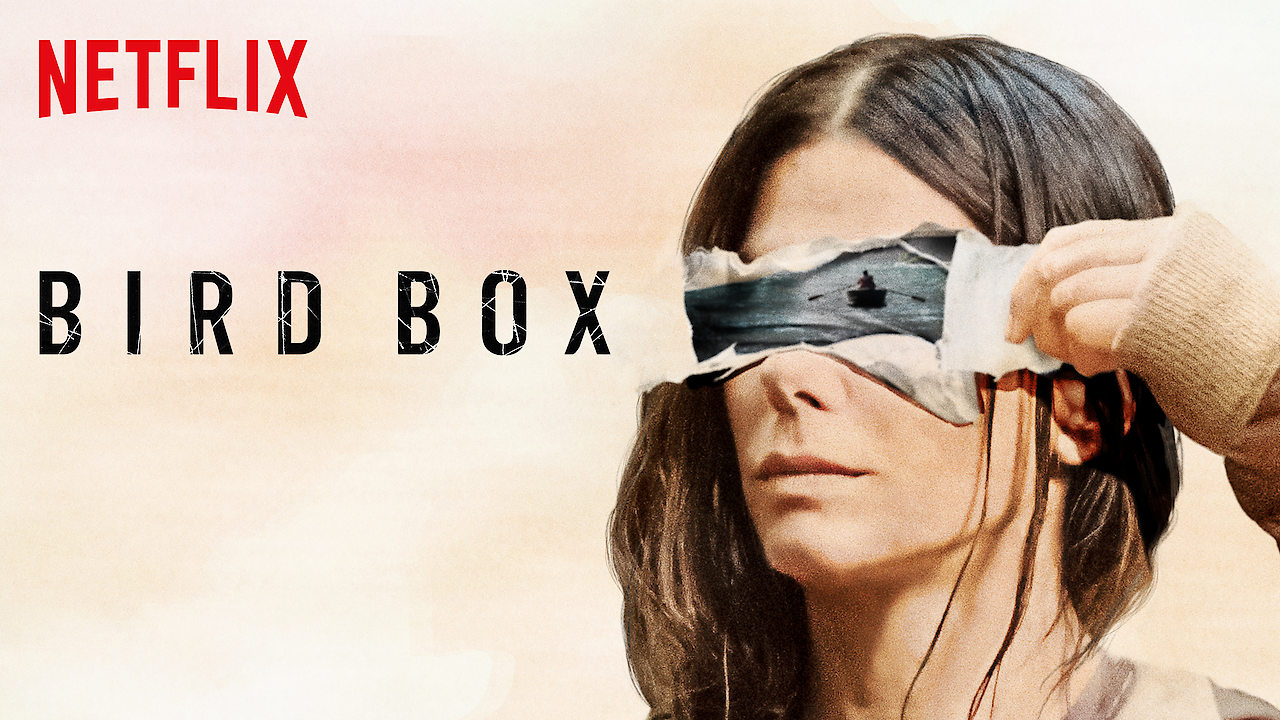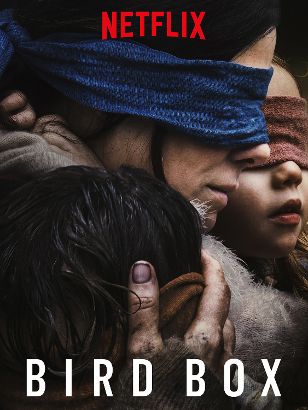
 BIRD BOX
BIRD BOX
Starring: Sandra Bullock, Trevante Rhodes, Sarah Paulson, John Malkovich, Jacki Weaver, Rosa Salazar, Danielle Macdonald
Director: Susanne Bier
Writer: Eric Heisserer
Based on the novel by: Josh Malerman
Reviewed by Sidney Morgan
This review CONTAINS MINOR SPOILERS.
The holidays are over. For many, this means a return to some sense of normalcy. Kids return to school, television shows return from their hiatus, and a few movies make their debut. Hoping to unwind, I looked at my options and came across one that had been released recently just in the thick of this crazy season: Netflix’s Bird Box. It’s a post-apocalyptic movie, but with an interesting premise. So, I gave it a watch.
Malorie’s (Sandra Bullock) world is about to change. For unknown reasons, invisible entities – invisible at least from the perspective of the viewer – begin appearing to humans. Whether they’re extra-terrestrial or supernatural in nature isn’t clear, but it doesn’t matter either. What does matter is that anyone caught looking at these “unseen” beings is afflicted and in a short time, dies. As the initial event unfolded, I was intrigued. Though the post-apocalyptic nature of the movie isn’t anything new, the contagion factor is unique. (** SPOILER ALERT **) The creatures use the victim’s memories against them, leading to a non-voluntary suicide, and that’s a terrifying notion. So, survival in this case only requires that a person not see these creatures, which should be easy, no? Well, it turns out it’s a little harder.

For starters, these creatures are smart. Knowing their power lies in being seen, they try hard to circumvent whatever obstacles the remaining humans put up. And I commend the writers for creating an evolving enemy, one that becomes better at killing. So as in most post-apocalyptic movies, the bulk of the story is about the remaining humans struggling to survive. And in Bird Box, this means that the world has to be navigated carefully. When Malorie and her two children travel down the river in an attempt to reach a safe haven (not unlike the promised safe zone in Resident Evil), they do so blindfolded and hidden under a blanket. Surprisingly, they manage to get down river remarkably well, but that’s beside the point. And though this careful treading of the outside world leads to some tense moments, it also exposes a small problem with the movie.
Very little is known about these creatures or what they look like. There are drawings, but whether those are accurate representations isn’t certain. We know they float, or fly, around, seeking out victims. Thankfully, houses are a safe place, as long as doors are shut and windows are painted over. But when they go to the grocery store, a public and readily accessible place, none of the creatures are floating inside. Is it because they need to feed somehow and just can’t stay in one place? Is it because there are too few of them (although, they did infest the entire planet)? And while hiding under a blanket, if the survivors can see through the fabric and the thinner parts of it, then why can’t these beings make eye contact?
Admittedly, I’m nitpicking, but if you’re going to introduce a unique contagion method, then you have to expect these kinds of questions. Nonetheless, barring this little issue, the story works really well because it isn’t about the creatures, but rather about the survivors.

The tension in the movie is split across two time periods. In the present, Malorie and her two children attempt to reach the safe haven they’ve been in contact with. Most of this time, the characters (the unaffected ones) are blindfolded in some form or other. There’s a feeling of claustrophobia that permeates these scenes, even though some of the camera shots are from the outside looking in on them. We can’t see much more than what Malorie and the children see, except when it serves to heighten the tension, and of course, provide context. Pulling the camera angle out to show the approaching rapids and their violent nature not only frightens our characters but viewers as well. And the second time period is in the past, explaining what happened to the world, though with a focus on Malorie as the central character.
Malorie is clearly guarded due to her past, and she’s more than happy to raise the child she’s expecting, alone. It’s this guarded approach that makes her hesitant and able to better survive. She’s hard and cold, independent and strong. And Sandra Bullock’s performance conveys those traits perfectly. But tempering that hard side is Tom (Trevante Rhodes), her love interest. In a world where hope is hard to come by, he makes sure that Malorie never loses sight of the reasons to want to survive. Their love for one another helps them deal with this new reality and with the children, who’ve had to forego the joys of childhood. I dug the on-screen chemistry between these two actors. They performed solidly, trying to be a loving couple while treading through the dangers.

There’s also an amazing supporting cast involved, with some very recognizable names. Playing Malorie’s sister Jessica, is the wonderful and versatile Sarah Paulson. It really was unfortunate she didn’t have a greater role. Then there’s Douglas (John Malkovich), owner of the house where our cast of characters spend time trying to figure out what they’re dealing with. His cynicism, or realism depending on your perspective, is a perfect counter to Malorie. And last, but not least, are the two children, Boy (Julian Edwards) and Girl (Vivien Lyra Blair) who perform well in light of the serious subject matter, including some pretty aggressive behaviors directed their way.
There’s great production value to the movie. Trying to convey the inability to see is difficult at best, given the medium, but it’s done remarkably well. House and car windows are painted to limit the view outside. Many scenes are filmed inside houses or buildings. When the action does take place outside, especially the river scene, it’s done in densely treed areas and foggy conditions, limiting the view. And even the blindfolds and blankets offer only the thinnest of veiled views. It works well and adds to the tension and rising panic.
The addition of the birds to assist survivors was a nice touch. As they journeyed the world, it was like people walking through a haunted house. But instead of creaking floors and soft howls announcing the danger, it was the bird’s frantic chirping that did so. And the inability to see just heightened that feeling a danger and dread. It was brilliant!
Verdict
Bird Box is a must watch. In line with many of the recent horror movies, it’s a slow burn, relying on gradual exposition and character development. But as the story develops, the suspense, the desperation to find a safe place and the terror grow. The tension is almost palpable and the paranoia contagious. At just over two hours, the story is captivating and never feels as though it drags on.
Bird Box is streaming on Netflix.



